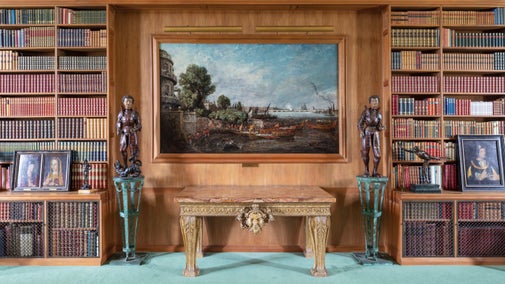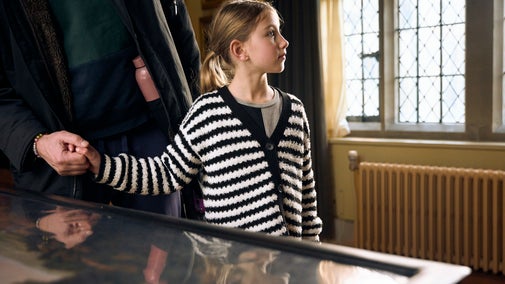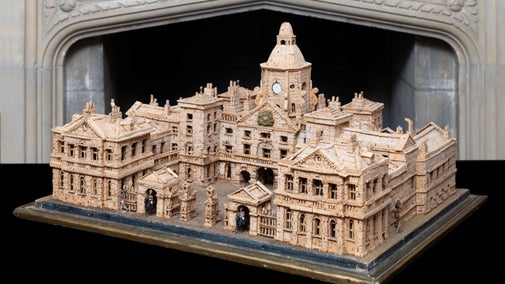
Anglesey Abbey and Lode Mill's collections
Explore the objects and works of art we care for at Anglesey Abbey and Lode Mill on the National Trust Collections website.

John Constable is widely regarded as one of the greatest English landscape painters, comparable only to his contemporary and rival J.M.W. Turner. Anglesey Abbey is home to a small yet significant collection of Constable’s work. The works range from early oil paintings of local landscapes to his largest ever canvas, Embarkation of George IV from Whitehall: The Opening of Waterloo Bridge, which has returned home to Anglesey Abbey, following conservation. Find out how you can see it along with a number of others within the collection.
Restored to its former glory, this remarkable painting is now back on show since returning from the Royal Oak Conservation Studio at Knole, Kent.
Anglesey Abbey is a home rather than a gallery, giving a sense of the kinds of spaces in which Constable’s 19th-century patrons enjoyed his art. Ongoing research, analysis and conservation of this little-known collection continues to reveal new dimensions of Constable’s practice.

George IV (then Prince Regent) embarked from the steps of Whitehall in a royal barge, crossing the Thames to open Waterloo Bridge in 1817, on the second anniversary of the Battle of Waterloo. Constable probably witnessed the ceremony, making pencil sketches of the scene that year.
This version of the subject, The Opening of Waterloo Bridge within Anglesey Abbey's Constable collection, has long puzzled art historians. Was it an abandoned attempt at a finished painting, a full-scale preparatory oil sketch, or a combination of the two?
Removal of discoloured varnish exposed lively mark-making, suggesting an artist working at pace across large areas. The improvements to the painting’s appearance are so dramatic, it almost looks like a different time of day or season. The texture of the paint surface and details can also be seen much more clearly.
Our understanding of our collections is constantly evolving. New imaging technologies could further our understanding of this painting in the future.
- Sarah Maisey, Senior Remedial Paintings Conservator
World-renowned Constable expert, Anne Lyles, has worked with the National Trust to reattribute the sketch, Summer Evening, Stoke-By-Nayland, to Constable. Purchased by Lord Fairhaven as a genuine Constable, the painting was later catalogued as ‘after’ Constable and disappeared from Constable scholarship. Constable has often been imitated and his children painted in a similar style, making it very difficult to identify works by the artist himself.
Compelling evidence now suggests this work is genuine. Constable used scraps of canvas for sketches, untacking the cloth from its stretcher and incorporating the holes into the body of the painting. This can be seen along the top of the canvas. This sketch is believed to have belonged to the artist’s son, Charles Constable, and can almost certainly be identified in a sale catalogue of his father’s belongings in 1869. These clues have helped identify this work as genuine, reestablishing its place in Constable’s legacy.
You can explore the collection in an online exhibition. Come face-to-face with the recently restored exhibition centrepiece, Embarkation of George IV from Whitehall: The Opening of Waterloo Bridge.

Explore the objects and works of art we care for at Anglesey Abbey and Lode Mill on the National Trust Collections website.
Discover the many layers that Anglesey Abbey has to offer. A Jacobean priory, once home to Lord Fairhaven.

Discover more about five of the most important treasures within the collection at Anglesey Abbey.

Discover the many layers that Anglesey Abbey and Mill has to offer and explore the long and fascinating history that stretches from 12th-century priory to 20th-century home.

Every day important conservation work takes place throughout Anglesey Abbey, in the house, gardens and Lode Mill. Take a look at what this involves and why we need your support to look after this special place.

The art and heritage collections we care for rival the world’s greatest museums. Learn more about the collection of paintings, decorative art, costume, books, household and other objects at historic places.

See the breadth of our collection of works of art, furniture and more: we care for around a million objects at over 200 historic places, there’s a surprise discovery around every corner.

Discover the stories behind some of the greatest artworks and artefacts looked after by the National Trust, as told in a dedicated book, 125 Treasures from the Collections of the National Trust.
